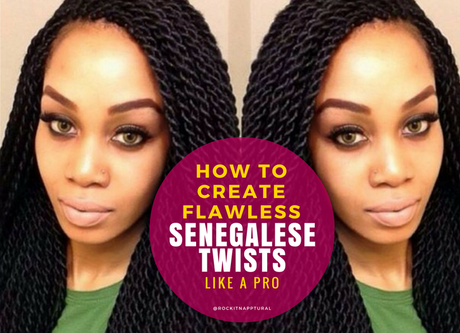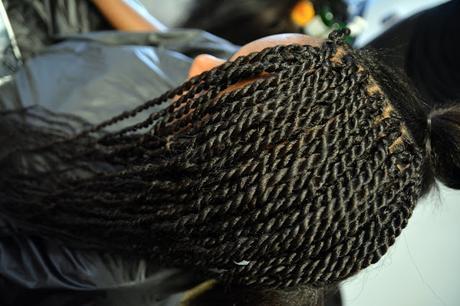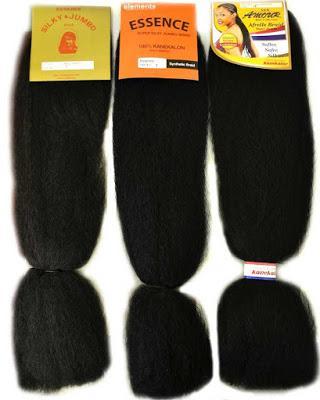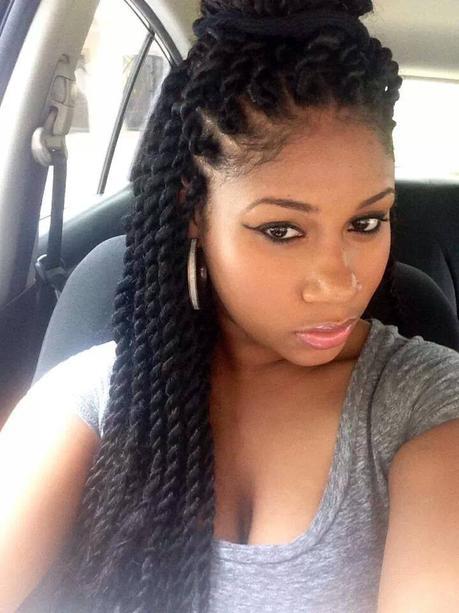
Senegalese twists, also called rope twists serve as a stunning protective styling option to give your hair a break from daily styling, manipulation and other damaging factors. What I love most about Senegalese twists is that they are extremely versatile and not as weighty as many other braided styles. Senegalese twists are done by adding extensions to your pre-parted hair and twisting the extension hair, one by one to each section, into your own hair from the root while continuing to twist. A method called the "invisible root method" is used to secure the extension hair to your own hair.
What's also great about Senegalese twists is that they're so easy that you can learn to do them yourself. It can easily cost me almost $200 to have a braiding specialist install Senegalese twists. In some areas, even more. You can save yourself a lot of money by learning to install the twists yourself. If you're thinking about trying your hand at installing your own Senegalese twists, here are a few pointers to help guide you along the way.

Read Also: 10 Best Places to Buy Afro-Textured Weave, Wigs and Extensions
WHAT TYPE OF HAIR SHOULD I USE FOR SENEGALESE TWISTS?

Kanekelon jumbo braiding hair is most recommended for this style, which is a much straighter hair texture than Marley or Toyokalon hair for instance. If you prefer to use Marley hair for your Senegalese twists, then this style would be considered as "Marley Twists" as opposed to Senegalese twists. Senegalese twists are known by their sleek and uniformed twisting pattern. The type of hair should be Kanekalon jumbo braiding hair, but the brand of hair you use is completely up to you.
WHAT TO DO BEFORE INSTALLING SENEGALESE TWISTS

Photo Credit: thefashionspot.com
Before installing your Senegalese twists, you should wash, condition and properly moisturize your hair. Cleanse the hair with a gentle, moisturizing sulfate-free shampoo such as Luster's Pink Shea Butter Coconut Oil Sulfate Free shampoo or Design Essentials Almond & Avocado Moisturizing and Detangling shampooYour natural hair will be out of reach and intertwined with the extension hair. You can avoid damage and breakage to your natural hair during the twisting process by properly preparing your hair for the protective style and the duration that it will be left in the style. You can wear Senegalese twists anywhere from 4-8 weeks before having to take them down. It all depends on how you care for your hair while in the style.
INSTALLING YOUR SENEGALESE TWISTS
Installing your Senegalese twists may take a little time at first, but once you get the hang of it you'll start to speed up the process. There are tons of how-to videos on how to install Senegalese twists. The great thing about the style is that when you decide to go the DIY route, it will save you a ton of money in the end.It may take you a little longer than a hair braiding professional, but with practice you will improve on both your speed and your technique. Some of the best, most thorough tutorial videos that I have found on how to install Senegalese twists are below and each video gives you step-by-step instructions on how to install Senegalese twists like a pro.
Tools Needed for Styling:
- 5-6 packs of Kanekalon Jumbo Braiding Hair
- Hair cutting scissors
- hair twisting gel (optional)
- Rat-tail comb (for parting hair)
- Spray bottle with water
- Duck bill clips
Senegalese Twist Tutorial (larger twists on tapered natural hair)
by Sadora Paris
Detailed Senegalese Twist tutorial (great for beginners)
by HowToBlackHair
Neat and Uniformed Senegalese Twist tutorial
by BeautyCanBraid
Recommended Twisting Gels for Installing Senegalese Twists:
- Organic Root Stimulator Loc & Twist gel
- Jamaican Mango & Lime Twisting gel
- Cantu Shea Butter Twist & Loc gel
- Africa's Best Organics Olive Oil Gel Twist & Lock
- Talia Waajid Black Earth Products Lock it Up Tight Hold gel
- Live Locs Loc and Twsist Retwist gel
- Isoplus Braid, Lock & Twist Molding Creme

Photo Credit: aliexpress.com
CARING FOR YOUR HAIR WHILE ROCKING YOUR SENEGALESE TWISTS
One of the most important things to remember when wearing any type of braided style is to be careful not to pull too tightly at the hair along your edges. The hair along your hairline is very delicate and many braiding specialist tend to pull very tightly while trying to grab the 'baby hairs' along your hairline.If you are having your Senegalese twists installed by a braiding specialist, be sure to communicate to them that you do not want the baby hairs included in your style or that you do not want your edges pulled too tightly. If you are installing the twists yourself, the same rules apply. Do not tug at your edges, pulling too tightly will cause thinning edges, hair loss or even traction alopecia.
Read Also: 5 Reasons Why Your Edges Are Thinning
You can create gorgeous updo hairstyles with Senegalese twists, however you want to avoid wearing these types of styles on a regular basis because the constant pulling on your edges can lead to breakage and hair loss.
You also want to keep your hair moisturized while wearing your twists. You can still wash your scalp when needed, just be careful not to cause too much friction or your braids will start to become frizzy and old. Dilute your shampoo with water to prevent buildup and to allow the shampoo to rinse out easily. Every few days, you should spritz your hair with water or a mixture of water and a light oil such as almond or jojoba oil to keep your scalp moist. Or, if you prefer you can use a leave-in conditioning spray instead.
If you allow your hair to become too dry it can lead to breakage and other damage. Spray both your scalp and down the braid itself to keep the hair that is intertwined with the extension hair moisturized as well. You pretty much want to care for your braided hair as if it were your own hair.
Oils You Can Use While Wearing Senegalese Twists:
- Almond oil
- Jojoba oil
- grapeseed oil
- Sunflower oil
- Coconut oil
- Tea tree oil (dilute in a carrier oil)
- Peppermint oil (dilute in a carrier oil)
TAKING DOWN YOUR SENEGALESE TWISTS
Your braids can remain in your hair for as long as they look neat and are not pulling and tugging at your own hair. As your new growth starts to emerge, the braided hair will remain on the initial strand where it was attached with your hair. You have to be careful because the twisted strand will be heavier than the emerging new growth and can also cause breakage of the new hair. I've heard of instances where leaving hair braids in too long can leave bald spots in your head.
I would not suggest taking down your twists if you do not have the time to patiently remove them. If you have somewhere to be, I recommend waiting until the following day or another time when you have absolutely nowhere to go. Pulling forcefully at the hair an cause unnecessary damage.
Cut the twists at least 2 inches below the point where your natural hair ends. Remove the twists with your fingers and detangle your hair as you remove each twist. Try to keep the comb out of your hair to prevent excessive breakage or shedding. You also want to avoid getting your hair tangled or create knots that you may have to trim.
Read Also: How to Know When Your Hair Needs a Protein Treatment
CARING FOR YOUR HAIR AFTER REMOVING YOUR SENEGALESE TWISTS
After removing all of the twists, follow-up with a hot oil treatment or pre-shampoo treatment to help restore any lost moisture and prepare the hair for manipulation. Because your hair has been out of the way for some time, you'll want to be gentle with your hair and take the necessary steps to styling your hair without damage.Wash your hair with a sulfate-free shampoo and follow-up with a moisturizing conditioner. If your hair feels dry or brittle,try a deep-conditioning treatment such as As I Am Hydration Intensive Conditioner, Shea Moisture Superfruit Complex Hair Masque, or Eden BodyWorks Coconut Shea Hair Masque Treatment.
If you notice that your hair lacks elasticity and feels limp, try a protein-rich conditioner to help restore your hair's ability to stretch such as Alba Botanicals Coconut Milk conditioner. You could also use an intensive protein mask like the Aphoghee 2-step protein treatment. Proceed with styling as you normally would. Stay away from direct heat for a while and allow your hair to breathe.
Following these steps when installing and rocking your Senegalese twists will allow you to protect your hair while continuing to care for it while it's tucked away. Senegalese twists are a gorgeous option for protective styling and can easily be done on your own hair. With patience and practice, you'll be well on your way to becoming just as good as the professionals!
Read Also: 5 Tips on How to Maintain Your Braids This Summer
How to Senegalese Twists Like a Pro video Courtesy of Sadora Paris Senegalese Twists Start to Finish in 5 Minutes video Courtesy of Breanna Rutter Neatest Twists Ever Tutorial video Courtesy of BeautyCanBraid
Photo Source: Aliexpress.com
If you like this post, be sure to SHARE!

